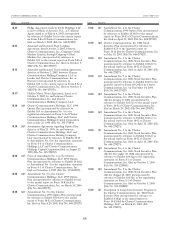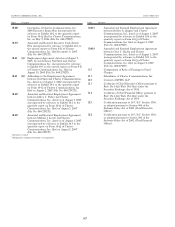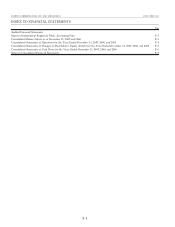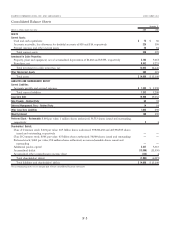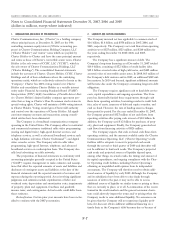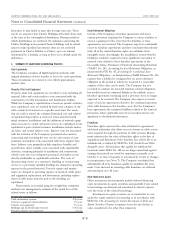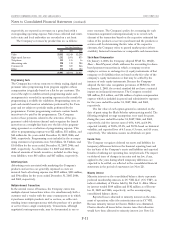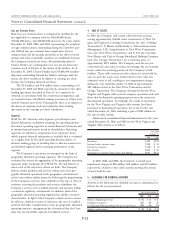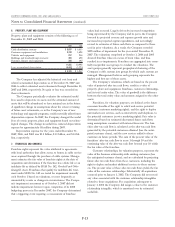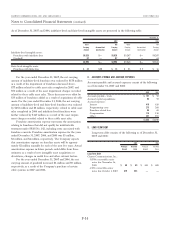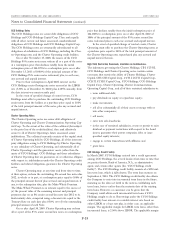Charter 2007 Annual Report Download - page 86
Download and view the complete annual report
Please find page 86 of the 2007 Charter annual report below. You can navigate through the pages in the report by either clicking on the pages listed below, or by using the keyword search tool below to find specific information within the annual report.
adverse market conditions, increased competition, or other unfa-
vorable events.
If, at any time, additional capital or borrowing capacity is
required beyond amounts internally generated or available under
the Company’s credit facilities, or through additional debt or
equity financings, the Company would consider issuing equity,
issuing convertible debt or some other securities, further reducing
the Company’s expenses and capital expenditures, selling assets,
or requesting waivers or amendments with respect to the
Company’s credit facilities.
If the above strategies were not successful, the Company
could be forced to restructure its obligations or seek protection
under the bankruptcy laws. In addition, if the Company needs to
raise additional capital through the issuance of equity or finds it
necessary to engage in a recapitalization or other similar transac-
tion, the Company’s shareholders could suffer significant dilution,
including potential loss of the entire value of their investment,
and in the case of a recapitalization or other similar transaction,
the Company’s noteholders might not receive principal and
interest payments to which they are contractually entitled.
Credit Facility Availability
The Company’s ability to operate depends upon, among other
things, its continued access to capital, including credit under the
Charter Operating credit facilities. The Charter Operating credit
facilities, along with the Company’s indentures and the CCO
Holdings, LLC (“CCO Holdings”) credit facility, contain certain
restrictive covenants, some of which require the Company to
maintain specified leverage ratios, meet financial tests, and
provide annual audited financial statements with an unqualified
opinion from the Company’s independent accountants. As of
December 31, 2007, the Company was in compliance with the
covenants under its indentures and credit facilities, and the
Company expects to remain in compliance with those covenants
for the next twelve months. As of December 31, 2007, the
Company’s potential availability under Charter Operating’s
revolving credit facility totaled approximately $1.0 billion, none
of which was limited by covenant restrictions. Continued access
to the Company’s revolving credit facility is subject to the
Company remaining in compliance with these covenants, includ-
ing covenants tied to Charter Operating’s leverage ratio and first
lien leverage ratio. If any event of non-compliance were to occur,
funding under the revolving credit facility may not be available
and defaults on some or potentially all of the Company’s debt
obligations could occur. An event of default under any of the
Company’s debt instruments could result in the acceleration of
its payment obligations under that debt and, under certain
circumstances, in cross-defaults under its other debt obligations,
which could have a material adverse effect on the Company’s
consolidated financial condition and results of operations.
Limitations on Distributions
As long as Charter’s convertible senior notes remain outstanding
and are not otherwise converted into shares of common stock,
Charter must pay interest on the convertible senior notes and
repay the principal amount. In October 2007, Charter Holdco
completed an exchange offer, in which $364 million of Charter’s
5.875% convertible senior notes due November 2009 were
exchanged for $479 million of Charter’s 6.50% convertible senior
notes. Approximately $49 million of Charter’s 5.875% convertible
senior notes remain outstanding. Charter’s ability to make inter-
est payments on its convertible senior notes, and to repay the
outstanding principal of its convertible senior notes will depend
on its ability to raise additional capital and/or on receipt of
payments or distributions from Charter Holdco and its subsidiar-
ies. As of December 31, 2007, Charter Holdco was owed
$123 million in intercompany loans from Charter Operating and
had $62 million in cash, which amounts were available to pay
interest and principal on Charter’s convertible senior notes.
Distributions by Charter’s subsidiaries to a parent company
(including Charter, Charter Holdco and CCHC) for payment of
principal on parent company notes, are restricted under the
indentures governing the CCH I Holdings, LLC (“CIH”) notes,
CCH I, LLC (“CCH I”) notes, CCH II, LLC (“CCH II”) notes,
CCO Holdings notes, Charter Operating notes, and under the
CCO Holdings credit facility, unless there is no default under the
applicable indenture and credit facilities, and unless each applica-
ble subsidiary’s leverage ratio test is met at the time of such
distribution. For the quarter ended December 31, 2007, there was
no default under any of these indentures or credit facilities, and
each subsidiary met its applicable leverage ratio tests based on
December 31, 2007 financial results. Such distributions would be
restricted, however, if any such subsidiary fails to meet these tests
at the time of the contemplated distribution. In the past, certain
subsidiaries have from time to time failed to meet their leverage
ratio test. There can be no assurance that they will satisfy these
tests at the time of the contemplated distribution. Distributions
by Charter Operating for payment of principal on parent com-
pany notes are further restricted by the covenants in the Charter
Operating credit facilities.
Distributions by CIH, CCH I, CCH II, CCO Holdings, and
Charter Operating to a parent company for payment of parent
company interest are permitted if there is no default under the
aforementioned indentures and CCO Holdings credit facility.
The indentures governing the Charter Holdings notes per-
mit Charter Holdings to make distributions to Charter Holdco
for payment of interest or principal on Charter’s convertible
senior notes, only if, after giving effect to the distribution, Charter
Holdings can incur additional debt under the leverage ratio of
8.75 to 1.0, there is no default under Charter Holdings’ inden-
tures, and other specified tests are met. For the quarter ended
December 31, 2007, there was no default under Charter Hold-
ings’ indentures, the other specified tests were met, and Charter
Holdings met its leverage ratio test based on December 31, 2007
financial results. Such distributions would be restricted, however,
if Charter Holdings fails to meet these tests at the time of the
contemplated distribution. In the past, Charter Holdings has
F-8
CHARTER COMMUNICATIONS, INC. AND SUBSIDIARIES 2007 FORM 10-K
Notes to Consolidated Financial Statements (continued)



